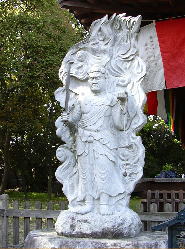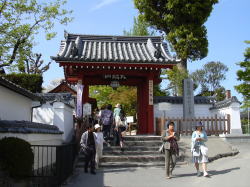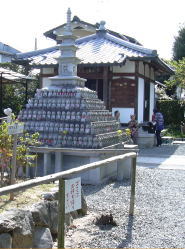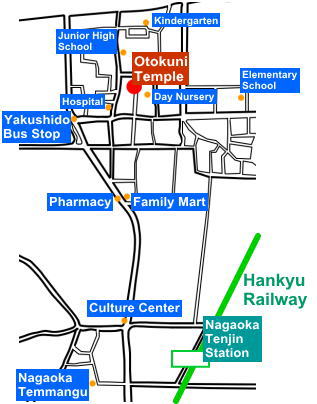
|
Temple of Stories and Peonies
A Temple Related to Historical Big Names: Prince Shotoku , Master Kukai and Others

|

|

|

|
乙訓寺
Otokuni Temple
 アンタ、知ってた~っ?この漢字って近所に住んでいる人しかなかなか読めないわよねー。「おとくに」って読むんだけどさ、なんで「おとくに」よ、って感じ。ま、いろいろ説があるらしいけど、なんでも、昔、葛野(かどの)って郡があってさ、そこから分離させてもうひとつ郡を作ろうかってことになったらしいのね。そのときにさ、じゃあ元からある郡のほうを「兄国」ってして、新しい郡を「弟国」にしようかってことになったらしいわ。でもさ、「おとうとのくに」というのじゃちょっと長いし、発音しにくいわよね。ま、そんなことがあったのかどうかわかんないけど、それが詰まって「おとくに」になったってわけ。別に「親国」と「子国」とか、「姉国」と「妹国」でもよかったんじゃないかしらんと思うんだけど。
アンタ、知ってた~っ?この漢字って近所に住んでいる人しかなかなか読めないわよねー。「おとくに」って読むんだけどさ、なんで「おとくに」よ、って感じ。ま、いろいろ説があるらしいけど、なんでも、昔、葛野(かどの)って郡があってさ、そこから分離させてもうひとつ郡を作ろうかってことになったらしいのね。そのときにさ、じゃあ元からある郡のほうを「兄国」ってして、新しい郡を「弟国」にしようかってことになったらしいわ。でもさ、「おとうとのくに」というのじゃちょっと長いし、発音しにくいわよね。ま、そんなことがあったのかどうかわかんないけど、それが詰まって「おとくに」になったってわけ。別に「親国」と「子国」とか、「姉国」と「妹国」でもよかったんじゃないかしらんと思うんだけど。 乙訓寺は真言宗豊山(ぶざん)派のお寺で、別名「牡丹(ぼたん)寺」とも呼ばれてるわよ。確かに、牡丹はすごいわよ。
でさ、この乙訓って地にはなんと弥生時代(紀元前3世紀~3世紀)ごろから人が住んでたんだって。すごいわね。弥生式土器を使ったり、お米なんかも作ってたのかしらん。古いだけあって、あまり知られていないお寺にしてはけっこう歴史があるのよね。ちょっと年表風にまとめてみたわよ。
乙訓寺は真言宗豊山(ぶざん)派のお寺で、別名「牡丹(ぼたん)寺」とも呼ばれてるわよ。確かに、牡丹はすごいわよ。
でさ、この乙訓って地にはなんと弥生時代(紀元前3世紀~3世紀)ごろから人が住んでたんだって。すごいわね。弥生式土器を使ったり、お米なんかも作ってたのかしらん。古いだけあって、あまり知られていないお寺にしてはけっこう歴史があるのよね。ちょっと年表風にまとめてみたわよ。Once there was a county, out of which people one day decided to make a new country, and named the new one "
The temple belongs to the
継体天皇518年
第26代継体天皇が都を弟国(おとくに)に移す。
Year 518
The 26th Emperor Keitai moved the capital city to the County of Otokuni .

603年頃(?)
聖徳太子が推古天皇の勅願で乙訓寺を創建。
Year ca. 603
Prince Shotoku constructed the temple following the edict of the 33rd Emperor Suiko .

でね、寺伝によると、乙訓寺は第33代推古天皇の勅願によって、聖徳太子が建てたことになってるらしいわ。それを裏付ける事実として、発掘の結果、法隆寺と同じ高麗尺(こまじゃく)が使われてるってことよ。法隆寺って言えばさ、もち、聖徳太子が建てたお寺よ。それからさ、乙訓寺が建てられたときの本尊は十一面観世音菩薩だったんだって。今は違うけどさ。
それでさ、推古天皇(在位592~628)ってのは日本で初めての女帝で、その摂政を務めていた聖徳太子はその甥なのよ。
According to an archaeological study, the temple was constructed using the ancient Korean measurement system, which was also used for
The principal image of
延暦3年(784年)
第50代桓武天皇が長岡に遷都。
Year 784
The 50th Emperor Kammu moved the capital city to Nagaoka .
 そのときにさ、乙訓寺を大増築したんだって。増築後の境内は南北百間以上もあって、講堂なんか九間に四間の大建築で難波京(なにわきょう)の大安殿と同じ規模、なんて言われてもピンと来ないわよね。
そのときにさ、乙訓寺を大増築したんだって。増築後の境内は南北百間以上もあって、講堂なんか九間に四間の大建築で難波京(なにわきょう)の大安殿と同じ規模、なんて言われてもピンと来ないわよね。一般的には一間は1.8メートルなんて言われているんで、無理やり計算すれば、当時の乙訓寺の全体の規模は南北180メートル以上あったってことになるわね。
難波京ってのは、今で言う大阪のあたりで、文字通りそこに建てられた都。歴史でも習った「大化の改新」の直後に第36代孝徳天皇が飛鳥から難波へ遷都。それから、第40代天武天皇のときに宮殿が火事で焼けてしまったので、その孫の第45代聖武天皇が再建。で、焼ける前の宮殿を前期難波宮って言ってさ、再建後のを後期難波宮って言うんだって。
The later
延暦4年(785年)
桓武天皇が皇太子の早良(さわら)親王を幽閉。
Year 785
Emperor Kammu confined Prince Sawara in the temple.
 早良親王というのは、桓武天皇の弟で、皇太子。なんで幽閉されたかって言うと、天皇の信任篤(あつ)かった藤原種継が暗殺されちゃってさ、どうもその暗殺に加担してたんじゃないかっていう疑いがかかったわけね。
早良親王というのは、桓武天皇の弟で、皇太子。なんで幽閉されたかって言うと、天皇の信任篤(あつ)かった藤原種継が暗殺されちゃってさ、どうもその暗殺に加担してたんじゃないかっていう疑いがかかったわけね。早良親王は断食して無実を主張したんだけど、結局、淡路島に島流しになってさ、その途中で死んでしまったのよ。なんか、可哀想ねえ。ほんとに無実だったらどうすんのよ!
早良親王の死後、悪いこと続きでさ、天皇のお母さんが亡くなるし、皇后も亡くなる、皇太子も重病になるわ、疫病が流行る、天変地異が起こるとかでね、さすがにこれは早良親王の祟りだ、てなことになったのか、朝廷は早良親王に「崇道天皇」という名前を追号し、お墓も奈良に移したりして恨みを鎮めようとしたらしいわ。
昔の人って災害とか悪いことが起きると、たいてい誰かの恨みとかで解決したのよね。今みたいに岩盤がどうのとか、プレートがどうしたってことはわからないから仕方ないけど。
After his death, unfortunate incidents happened one after another. Both the emperor's mother and his empress died. The new Crown Prince became ill and epidemics and natural disasters hit the capital. All these misfortunes were attributed to

